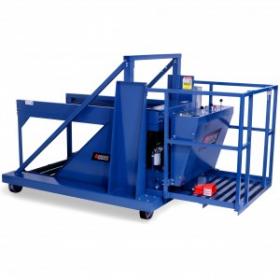A battery forklift charging station is an essential part of keeping forklifts operational and productive. This helps maintain a smooth workflow and prevents delays due to unexpected battery issues.
However, charging forklift batteries can be dangerous if not done properly. Therefore, you must follow certain requirements and precautions.
In this blog, we will show you the standards for choosing and installing your charging stations. For a personal consultation on the right equipment, give us a call.
Functional Requirements for Charging Stations
When it comes to selecting a charging station, there are a number of options available. From small stationary stations to mobile stations and large stations designed to keep a fleet of forklift batteries charged around the clock.
With the many options available, it’s important to understand your facility’s requirements first. Consider the following.
Capacity
Two of the most important factors for a charging station are the weight and power capacities. Ensure that the charging station is able to handle the collective weight of all your batteries and that the area’s electrical infrastructure can handle the charging station’s power requirements.
Proper Ventilation
Forklift batteries release hydrogen gas during the charging process, which can be potentially hazardous in confined spaces. Adequate ventilation is essential to dissipate these gases safely. Install charging stations in well-ventilated areas or invest in ventilation systems specifically designed for battery charging areas to maintain a safe working environment.
Space and Layout
Efficient use of space is vital for a well-organized forklift charging station. Plan the layout to allow easy access for forklifts to dock at charging stations without causing congestion or blocking walkways. Adequate spacing between charging stations ensures proper ventilation and facilitates maintenance tasks.
Mobility
Some facilities will have many batteries and a large dedicated space for charging. Others require more mobility. Consider your space and operational processes to determine the best charging station(s) for your business.
OSHA Safety Standards for Forklift Charging Stations
In addition to the functional requirements, there are also safety considerations. Forklift batteries can be a hazard when not properly handled. To keep your employees safe, it is best to abide by OSHA’s safety requirements for forklift charging stations.
We have listed their requirements below. You can click here for more information on OSHA’s Forklift charging standards.
Recommendations for the charging area:
- No smoking
- Warning signs posted
- Adequate fire protection
- Ample and readily available water supply for flushing and neutralizing spilled electrolyte
- An eyewash able to provide a 15 minute flow. (Figure 2) Note: For large installations, there should be a plumbed drench shower and an eyewash.
- A phone or other means of communication in the event of an emergency
- Adequate ventilation to avoid the build up of hydrogen gas during battery charging
- Soda ash or other neutralization materials in the immediate area
- A dry chemical, CO2 or foam fire extinguisher
- Means to protect charging apparatus from damage from trucks
Requirements and Recommended Practices:
- Properly position trucks and apply brakes before attempting to change or charge batteries. (Figure 4) [29 CFR 1910.178(g)(8)]
- Use a lifting beam or equivalent material handling equipment when lifting the battery. (Figure 5) Do not use a chain with two hooks. This may cause distortion and internal damage. [29 CFR 1910.178(g)(4)]
- Charge batteries in the designated battery charging area. (Figure 6) [29 CFR 1910.178(g)(1)]
- Facilities shall be provided for flushing and neutralizing spilled electrolyte, for fire protection, for protecting charging apparatus from damage by trucks, and for adequate ventilation for dispersal of fumes from gassing batteries. [29 CFR 1910.178(g)(2)]
- When charging batteries, pour acid into water. Never pour water into acid. [29 CFR 1910.178(g)(7)]
- Care shall be taken to assure that vent caps are functioning. The battery (or compartment) cover(s) shall be open to dissipate heat. [29 CFR 1910.178(g)(9)]
- Prohibit smoking in the charging area. [29 CFR 1910.178(g)(10)]
- Take precautions to prevent open flames, sparks, or electric arcs in battery charging areas. [29 CFR 1910.178(g)(11)]
- Remove all metallic jewelry before recharging. Tools and other metallic objects shall be kept away from the top of uncovered batteries. [29 CFR 1910.178(g)(12)]
- Wear personal protective equipment (face shield, safety goggles, neoprene or rubber gloves and apron). [29 CFR 1910.132]
- Where the eyes or body of any person may be exposed to injurious corrosive materials, suitable facilities for quick drenching or flushing of the eyes and body must be provided within the work area for immediate emergency use. (Figure 7) [29 CFR 1910.151(c)]
- Check the electrolyte level before recharging. Record the specific gravity with the hydrometer in the service log. Check the pilot cell.
- Check the water level. Do not add water prior to recharging. Record in service log.
- Check the voltage. If the battery has sealed vents, do not recharge with a current greater than 25 amperes.
- Unplug and turn off the charger before connecting or disconnecting the clamp connections.
- Attach the positive clamp (+, usually colored red) to the positive terminal first and then the negative clamp (-, usually colored black) to the negative terminal, keeping the proper polarity.
- Turn off the charger if the battery becomes hot or the electrolyte fluid comes out of the vents. Restart charging at a lower charging rate.
- Check water level after charging. Add distilled water or de-ionized water if water level is below level indicator. Record in service log.
- Return battery to forklift with lifting beam and secure in place after charging. [29 CFR 1910.178(g)(4) and (g)(5)]
- Check the indicator on the hour meter to see that battery is fully charged.
Ensuring your charging station fits all the requirements
A well-designed forklift charging station is the backbone of a smoothly functioning material handling operation. Picking the right equipment and creating the space for your charging station is a vital part of having an efficient charging space.
To find the right equipment and for consultations, call Beal Industrial Products, your forklift battery supplier.




